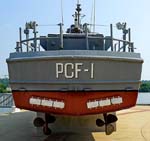Corroded aircraft carrier being sent to become scrap metal.
What is cavitation corrosion?
Cavitation corrosion is a type of corrosion that fatigues a material by creating small cavities in the material. This is usually caused by liquid moving through a pipe or over an object. The corrosion is created by a liquid changing direction rapidly and wearing the metal like in pipes, or when bubbles created by a pump or impeller strike a surface repeatedly and cause cavities. Cavitation corrosion in engineering is a big problem because the cavities can weaken a material to the point where it breaks or leaks. The effects can be lessened by smart engineering and understanding water flow ie by limiting the number of sharp turns in a pipe or reducing bubbles with a different impeller in a pump or a different propeller on an engine.
Corrosion in a pipe.
Cavitation on a propeller, bubbles are created by the cavities
When two dissimilar metals are electrically connected one of those metals will corrode more than the other, this is the basis of anodes. Metals are ranked on their corrosive resistance on the galvanic scale at the top the most resistance at the bottom the least resistant to corrosion. Essentially the lower resistant metal will take almost all of the corrosion from the more 'Noble metal'. Certain metals work far better when connected than others.
This poor piece of engineering, with no regard for the galvanic scale, Has left the metal on the right completely corroded and the other metal relatively free of corrosion.
Stray corrosion?
Stray corrosion is where metals that are not directly attached to a galvanic system, are corroded. Electrical current can travel through objects and corrode other metals in the immediate area.
Stress corrosion?
Stress corrosion is the long term wearing of a material due to forces and stress on the part. A metal that originally was very high in tensile strength can become ductile after repeated stresses and can eventually suddenly break. Stress corrosion also effects rubber pipes by cracking and fraying the edges.
Bolt can crack suddenly after repeated and long term stress
Corrosion Fatigue?
Corrosion fatigue is the degradation of a material because of: the environment with corrosive substances and: repeated stresses such as the stress that and engine creates on the materials.
Crevice corrosion?
Crevice corrosion happens when a corrosive substance like water is trapped and stagnant in a crevice or crack. the most common place for crevice corrosion is under the heads of bolts where water can accumulate.
The screw on the left has been corroded by crevice corrosion.
Electrolysis is a chemical change that happens when an substance (like water) has an electrical current passed through it. Essentially the water is separated into the different elements that make up water.
How do you prevent corrosion?
Corrosion can be prevented in many ways, the marine industry employs may of these methods to reduce the effect of corrosion on boats. One of the most common methods is Galvanisation. This is the process of applying a protective metallic coating to an underlying piece of metal, to protect it from rusting. The protective coating is usually made of a metal with a high corrosion resistance, when this metal is corroded the piece can be galvanised again to protect it further. Another method is the use of anodes to protect a metal hull or other parts. An Anode is essentially just a sacrificial piece of metal that when connected in an electrical circuit with a hull 'draws' corrosion away from the other metal. It works on the principle of galvanisation where one metal is severely corroded and can be replaced to protect the hull, changing an anode is far easier than changing a hull!
Zinc anodes can be seen on the hull below the water line.
What is bonding in the marine industry?Bonding is the system of keeping electrical components of a boat isolated from one and other. the reason for this is when marinas are full of boats there can be a lot of DC current in the water this can degrade the anodes on a boat very rapidly, by isolating electrical currents the anodes can be spared.
http://www.sailmail.com/grounds.htm
What are sacrifical anode made of?
A sacrificial anode is usually made of zinc or any other metal that is low on the galvanic scale, this ensures that corrosion will be directed to the less noble metal. Anodes should be replaced when half of the anode has been degraded, the anode will lose efficiency the more degraded it is.
Large Zinc sacrificial anodes for boat hulls.
References:
http://www.kastenmarine.com/corrosion.htm
http://en.wikipedia.org/wiki/Galvanising







hey mate awesome work, lots of good information
ReplyDelete